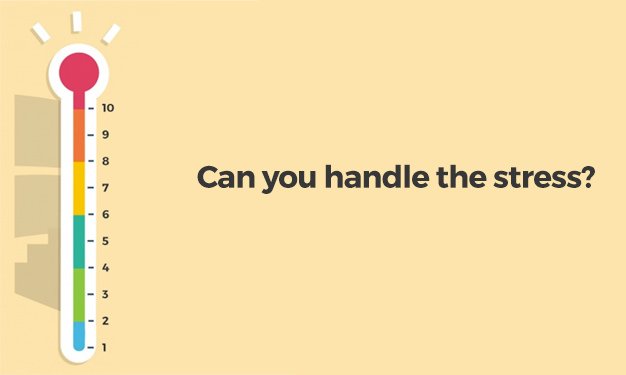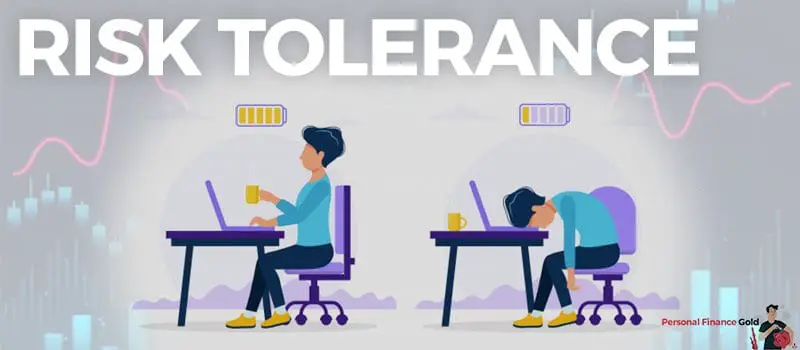Saving and investing money to grow your wealth can be stressful, knowing what your risk tolerance number is could be a game changer in how you see things and take action.
In 2010 I was going nowhere, my finances sucked.
In 2013 I started understanding personal finance, learning more about it, and getting myself (and my family) in a better situation.
In 2014, I was saving monthly. I knew all about stocks and trading, and started to do day-trading, forex trading, and binary trading often. Boy did I stress the hell out.
By the end of 2015, I called it quits. I absolutely wanted to continue investing, but I was stressing out a ton from all the ups and downs that came with frequent trading. I was burnt out.
Ever since then, I’ve stopped trading so frequently, and have instead been investing regularly on a monthly basis, and only checking my balances about 1-2 times a month.
Nothing has broken since.
What I wish I knew back then, was my risk tolerance score, where I stood from 1-10 on how much risk I can take without freaking out.
Over time, I reflected on what I did in the past, how I am as a person, and came to the understanding that I am a 4 from the 1-10 rating.
I’m happy to invest away all the money I earn on a monthly basis, as long as all my monthly obligations like mortgage payment, credit card bills, and car payments are covered.
If all my invested money tank for months, it’s whatever, I still own the same amount of shares of that company, the “perceived value” of that stock just went down for a bit. And I was in no rush to take the money out anytime soon anyways.
I was saving, paying my bills, and investing the rest. Life was calm again.
In this post, I hope to help shed some light on what risk tolerance is, and how to find out what your number is today.
What is risk tolerance in personal finance?
Risk tolerance, usually associated with age (the older you get the less risk you want to take), is a degree of risk you’re willing to take as an investor to get a desired return. It’s known that the more risk you take (buying riskier assets, or stocks over bonds in general) can potentially bring you higher returns in a shorter period of time.
When doing my research on this topic, I came across tons of different versions of risk tolerance for different business industries (from project management, to insurance).
I didn’t want any of that, I just cared about it in terms of personal finance.
In personal finance, risk tolerance is basically the amount of risk that you can tolerate based on your lifestyle, your needs, and your goals.
That’s my personal definition, no Websters dictionary here.
I’m a 4 because..
- I love to grow my wealth, but I get extremely stressed if I go backwards. I found that slow and steady growth is better.
- I’m married with a child, so I have to make sure we’re covered before I consider taking any more risks.
- I work for myself, my income is not consistent, so I have to make sure my saving/investing ratio is almost even. This way I have a big pot of money to fall back on incase anything happens.
- I had stressful times in my early years around debt. I didn’t have a ton of it, but it always stressed me out. Knowing myself better, I always avoid big debt, and pay it off quick if I have to take it on.
Knowing all this and more, I chose the number 4 years ago. I’d reflect on it a few times a year, and confirm that it’s exactly my number from 1-10.
What is the difference between risk tolerance and risk capacity?
I’m gonna be real here, and not put you to sleep with academic talk.
Risk tolerance is how much “stress” I am okay to take on, before I my face goes red hot like a volcano.
Risk capacity is how much risk you “need” to take in order to get to your financial goals.
You know that I’m a 4 in risk tolerance.
Let’s say I wanted to get to $1 million by the next 7 years.
If I wanted to do that, I would work it out that my risk capacity (riskier investments, lowering savings to allocate more to investments, etc.) would have to be an 8 so I can get to the $1 million mark.
Should I do it? That’s where knowing your risk tolerance and also your risk capacity can be helpful.
Know your risk tolerance number first, it’s level 1. As you get better at personal finance and set big goals, you want to have a number for your risk capacity too.
It’s a ballpark number you give, just like you did for your risk tolerance, that helps you compare your personality with your big goals, to see if you’re close.
If your risk tolerance is 5, and your risk capacity was a 6 or 7 based on your financial goals, you’re not really to far off to make some adjustments and make both ends match.
If I’m a 4, and my risk capacity number is an 8, it’s pretty far off. I might want to add a few more years to my goal, or adjust my expectations.
Growing your wealth is a great game to play, just don’t stress the hell out from playing it. You can be both calm and grow your wealth, by comparing your risk tolerance and risk capacity numbers, and setting expectations.
What is the difference between risk tolerance and risk threshold?
Again, let’s make this simple.
Risk tolerance is your emotional level, its a number that defines you. I’m a 4.
Risk capacity is the number given to your big goal, based on the $ value and timeline you set out. If I’m a 4, and my risk capacity number for my goal is an 8, it’s not aligned. Time to adjust.
Risk threshold is another great number to have in mind, it’s the number you can give different investment opportunities based on how risky they are, basically finding good investments that match your risk tolerance number.
Let’s review some investing opportunities and give them a number:
- Real estate investing could be an 8. With high returns, it also has a bit of stress if you can’t always have a tenant living in there, and high maintenance.
- Bitcoin investing is a 7, very volatile, and you somewhat understand how it works.
- Buying stocks in the marketplace is a 6, you can find good companies you trust to invest in, and hope to gain from the upside (and lose from the downside).
- Buying a mutual fund could be a 4, because now you’re buying many pieces of many companies, diversifying your risk.
- Putting money into a high yield saving account is a 1, with almost no risk you can put lots of money away, earning a fairly decent but low interest rate.
These are numbers I made up based on my personality. If you’re a Bitcoin ninja, then you’d maybe rate Bitcoin a 3.
Do the exercise of listing out a bunch of investment opportunities like I just did, and give them numbers based on your own personality like I did above.
Because my risk tolerance is a 4, I can go back to this list, and see that my risk threshold would ideally be limited to buying mutual funds and putting money into a high yield saving account.
I could definitely do more like buying bitcoin, it would just be a much smaller piece of my total investment pie.
Do you see how doing this risk threshold homework and comparing it with your risk tolerance can be very helpful to your piece of mind?
It helps make a clear map, on what you can freely invest in if you have the money, and what things are above your threshold and should be a smaller percentage of your investments.
Note that this doesn’t mean you can’t invest in a variety of things, you just balance out your entire portfolio making bigger investments in things within and below your risk threshold number, and smaller amounts in things above that number.
What’s my risk tolerance score?
I already mentioned before that getting your own risk tolerance number just requires you to reflect a bit on your past choices to see if you were super stressed on that $1,000 bitcoin investment or didn’t care much that it dropped to $547 in a few days.
Reflect on your lifestyle needs, who else depends on the income, if your income is stable, how much you already have in savings, and so on.
After some time, pick a number from 1-10, maybe you’re a 6.

Stick with that number for some time, and reflect on it whenever you can, maybe you’re a 6 for the rest of your life, or it goes up and down slightly as you experience life’s peaks and valleys.
For the last 5-6 years, I have been a 4, and don’t really see that changing anytime soon. Even though my savings are growing, my biggest personal reason to stay at this number is that I like growth, but hate declines.
I’d rather grow slow than see big dips.
How to make good personal finance decisions based on your risk tolerance

I really really hope this post (of the many I’ve written) is helpful. Knowing my risk tolerance has saved me from making wrong investing choices over the years, and avoiding things that would stress me out.
I stopped day trading immediately, and my stress went away. I kept my saving/investing percentage to an even 50/50, and that kept me cool always.
Comment below and tell me what you think your risk tolerance number is right now, maybe you’ll see this post in the future and reflect on what you wrote.


